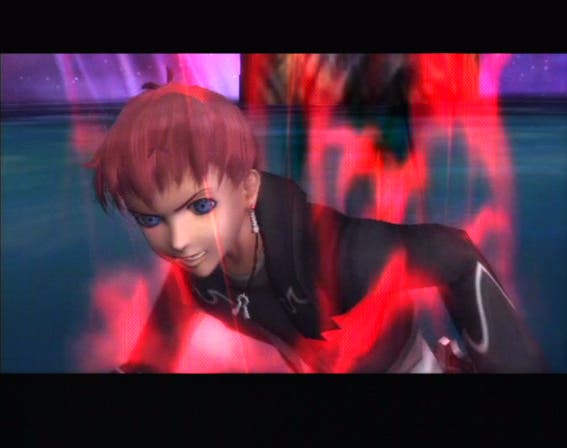Xenosaga Episode III: Also Sprach Zarathustra
The saga concludes.
Please bear with this. While a review of the finale to a three-part epic J-RPG science-fiction saga might seem irredeemably tedious to all but the most unflinchingly geekish consumer, there are lessons herein that are important to the rest of gaming. Ideas that should and shouldn't be repeated and, remarkably, beneath the rubble of this prematurely destroyed series, the pleading whisper of a good game trapped in a fallen framework.
Originally intended as a six-part run of games that would be released over no less than three console generations spanning a decade, the Xenosaga vision has been mercilessly downsized in recent times. Indeed, with declining sales as the story has progressed it was perhaps debateable as to whether we'd see any form of conclusion to this, Tetsuya Takahashi's lovingly crafted universe. So, there's some sense of relief for fans in this, the final (foreseeable) Xenosaga game: they at least made it to an end.
But first, a brief history of time.
Takahashi's Xeno universe first big-banged into existence in the 1998 PSOne release, Xenogears. Big in Japan, small in the US (thanks to its Church bashing overtones) and non-existent in Europe, its release saw the esteemed producer leave Square-Enix to set-up Monolith Software, his head still full of the details of the complex and vast universe he had spent the last few years of his life creating. Rather than discarding all that to begin afresh a new game, Takahashi began work on Xenosaga, an ostensibly distinct world to that of Xenogears (due to the obvious contractual limitations) but one in reality closely linked to the former game in style, theme, content, mythology and much of the detail.

Xenosaga 1's release introduced us to Shion Uzuki, a bespectacled geekgirl working for the multigalactic company, Vector Industries, on a robot intelligence codenamed KOS-MOS. A host of other supporting characters with alien jobs and histories but recognisable motivations and emotions filled out the characterisation colour and the dark threat of the Gnosis (ethereal creatures that can kill the living with one touch terrorizing the universe with increasing frequency) provided the shading needed to give the story depth and fear.
The game divided critics with its bombastic highbrow philosophy, impenetrable unfamiliar terminology, linear progression and, most notably, the long hours of non-interactive cut-scenes. But the cinematics were expertly-produced, the story while demanding was interesting, and the battle system (one of the few times the player wrestled control of the game's progression from Takahashi) fun to play. And so, as this space soap-opera has progressed and characters have seen their designs sexed up, stories outworked and questions added to, still these core elements of the series remain constant.
So as Xenosaga III comes in to land, seeking to wrap up the ubiquitous threads the earlier games have left hanging and frayed, players who have enjoyed the former games will know exactly what to expect. For anybody else here struggling to contend with the series' practical history, you have little hope unravelling its internal machinations. You see, any good storyteller knows that the key to creating a successful and believable universe is to know everything about it before you point pen to paper, camera to star or polygon to background. And any great storyteller knows that you don't go around telling the reader/viewer/player about all these details. Rather, you let the detail and fact of the universe permeate the story subtly and without fanfare as mere incidentals that reveal themselves naturally.

Xenosaga takes this line religiously but its complex and alien terminology makes it very difficult to jump in on for a new player. Indeed, both newcomer and veteran alike will need to regularly consult Xenosaga III's magnanimous internal encyclopaedia of terms in order to stay abreast of the twisting and terminology-heavy narrative.
And that narrative has some problems outside of its foreign vocabulary. While the game opens innocently enough - in an opening curiously reminiscent of Final Fantasy VII, recently-resigned protagonist Shion breaks into former employer Vector Industry headquarters in the search of incriminating evidence - it's not long before the philosophy and meta-physical posturing so beloved of the makers is heaped upon the player.
Xenosaga's obsession with philosophy is frequently stifling. Whereas a series like Star Wars or Lord of the Rings focuses it's meta-narrative on basic good vs. evil, brought to life and interest through the protagonist's emotions, relationships and grey moral choices, Xenosaga reaches for more ethereal plains.
Stuffed with references to Jung and Sartre (the German language subtitle of each game is named after a work of Nietzsche) this is a game obsessed with the existence of god, the nature of mankind's telos and the purpose of history's religious artefacts. Problematically, all the characters in the game are also obsessed with these themes often to the exclusion of comforting recognisable human attributes. For players not acquainted with such sci-fi anime vice, this can make your team difficult to identify with, often unbelievable and has the likely cumulative effect of making undedicated players not really care what happens to them or their universe.








